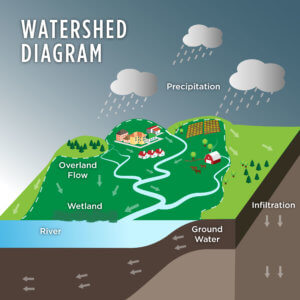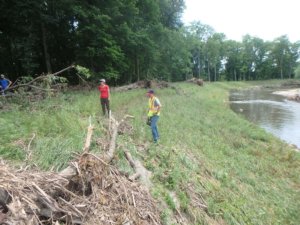Watershed Management Authority Provides Tool to Merge Resources
The effective management of the land, water, wildlife, and other natural resources in our nation’s watersheds requires a process capable of evolving with the constantly changing environmental conditions. In many communities, this is increasingly leading to the creation of a Watershed Management Authority (WMA) to better establish rules and procedures for communal, economic, and environmental progress.
Originally created to address flooding issues beyond the boundaries of a single jurisdiction, WMAs have expanded to provide a collaborative approach to planning for the whole watershed. Most watershed management authorities are typically made up of city and county leaders, as well as soil and water conservation agencies that govern or reside within the watershed. Other WMA partners can include county agencies, community leaders, and nonprofit organizations, each of which has a unique role to play and brings diverse resources to the table.
Watershed issues do not confine themselves to government-regulated boundaries. Instead, they flow freely, carrying and depositing pollutants and excess sediment along their path. Using multiple tools, including public meetings and discussions, WMAs can identify issues before they arise, stay ahead of modifications in land use, and navigate changes in populations and land use patterns.
By expanding beyond traditional domains, WMA partnerships allow members to offer a comprehensive and efficiently-integrated range of services. This approach enables members to draw on expertise from various sectors to achieve the best possible solution to the watershed’s wide-ranging issues. As a member of multiple WMAs, the professionals from Snyder & Associates guide the development and implementation of plans that promote healthy and resilient watersheds capable of responding and adapting to increasing changes.
Flood Reduction & Water Quality Improvements
 One main focus of watershed management is the creation of a comprehensive plan that establishes practical objectives to reduce watershed flooding, contamination, and excessive siltation. “The old mentality of stormwater (watershed) management was out-of-sight, out-of-mind. This way of thinking has damaged our waterways from both a water quantity and quality perspective,” explains Jeff Walters, Principal Environmental Scientist for Snyder & Associates. “Best management practices (BMPs) for stormwater now call for controlling and treating it at the source using an entire watershed perspective.”
One main focus of watershed management is the creation of a comprehensive plan that establishes practical objectives to reduce watershed flooding, contamination, and excessive siltation. “The old mentality of stormwater (watershed) management was out-of-sight, out-of-mind. This way of thinking has damaged our waterways from both a water quantity and quality perspective,” explains Jeff Walters, Principal Environmental Scientist for Snyder & Associates. “Best management practices (BMPs) for stormwater now call for controlling and treating it at the source using an entire watershed perspective.”
This updated, holistic approach is one of the primary benefits of WMA applications. With a single organization coordinating efforts, the conversation changes from localized impacts to system-wide improvements. Members of the WMA have in-depth knowledge of the common impacts and how each BMP works in harmony with each other.
While balancing improvements across boundaries is one of many factors at play in every watershed, regulations provide their own patchwork of management challenges. Water quantity regulations are typically state-driven, while water pollution regulations are primarily federally based. On the other hand, land-use management is generally coordinated by local governments. Therefore, land-use decisions that affect water use and quality may involve dozens of diverse regulatory factors.
Snyder & Associates extensive experience has solidified our understanding of stormwater and environmental industry standards and enhanced our familiarity with federal, state, and local regulations and permitting requirements in countless jurisdictions. This in-depth knowledge allows us to navigate the regulatory process diligently and efficiently, helping keep WMA projects on time and on budget.
Leveraging Funds for Watershed Improvement Efforts
Funding is a common, if not universal, challenge affecting many WMA projects. Since there is no dedicated revenue source, locating financing for the many improvements can rapidly become competitive. By weaving together resources to support a watershed-based approach, these partnerships can leverage existing funds more efficiently and, in doing so, enhance their ability to meet the urgent needs of the watershed systems.
Funding mechanisms for water resource management activities can occur at the local, regional, and county levels, with additional funding available through state and federal agencies. Using comprehensive planning efforts, WMAs are able to have projects detailed in advance of available funding. With specific plans at the ready, these WMAs can immediately apply when the opportunities for resources arise. Our experts continuously monitor funding sources for watershed-focused improvements, enabling us to quickly capture funding in support of their mission.
Making Watershed Management Authority Plans a Reality
Through collaboration, communities often gain a deeper understanding of how their water resource decisions and policies can have a lasting impact beyond their jurisdiction. Communities that adopt a watershed perspective for stormwater management often experience major improvements within their watershed.
“During the time our team assisted the Fourmile Creek Watershed Management Authority (FCWMA), many successes were achieved,” explains Walters. “They’ve completed a plan that outlines goals, policy changes, future action items, and funding opportunities for projects within the Fourmile Creek watershed.”
The Snyder & Associates team has assisted with the implementation and ongoing efforts of many WMAs across the Midwest. When working with these groups, our team leverages a full range of civil engineering and environmental services to ensure every goal is met. Our experts help guide conversations and thoughtfully balance expectations, ensuring that the final product satisfies all members.
If you’re interested in discussing the steps towards forming a WMA, please contact the Snyder & Associates office near you.

